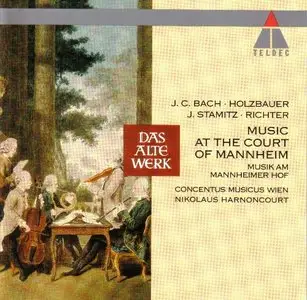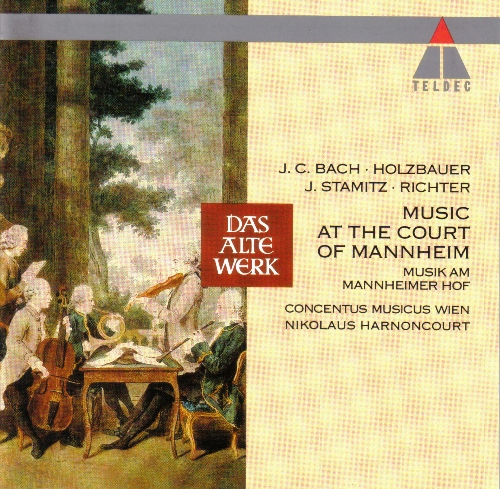Music At The Court Of Mannheim
Ripped with DbPoweramp, no cue, FLAC (tracks) + MP3 at 320 kbps CBR. | 292.37 Mb (FLAC) + 130.61 Mb (MP3) | 53:45 minutes | Full artwork & covers.
classical | Das Alte Werk - Teldec Records, Recorded at Opera Studio, Vienna, May 1963.
Ripped with DbPoweramp, no cue, FLAC (tracks) + MP3 at 320 kbps CBR. | 292.37 Mb (FLAC) + 130.61 Mb (MP3) | 53:45 minutes | Full artwork & covers.
classical | Das Alte Werk - Teldec Records, Recorded at Opera Studio, Vienna, May 1963.
Mannheim school refers to both the orchestral techniques pioneered by the court orchestra of Mannheim in the latter half of the 18th century as well as the group of composers who wrote such music for the orchestra of Mannheim and others. The court of the Elector Carl Philipp moved from Heidelberg to Mannheim in 1720, already employing an orchestra larger than that of any of the surrounding states. The orchestra grew even further in the following decades and came to include some of the best virtuosi of the time. Under the guidance of Kapellmeister Carlo Grua, the court hired such talents as Johann Stamitz, who is generally considered to be the founder of the Mannheim school, in 1741/42, and he became its director in 1750. The most notable of the revolutionary techniques of the Mannheim orchestra were its more independent treatment of the wind instruments, and its famous whole-orchestra crescendo. Members of the Mannheim school included Johann Christian Bach, Johann Stamitz, Franz Xaver Richter, Carl Stamitz, Franz Ignaz Beck, and Christian Cannabich, and it had a very direct influence on many major symphonists of the time, including Joseph Haydn and Leopold Hofmann. The orchestra commissioned Joseph Haydn to compose six symphonies (the “Paris Symphonies” Nr. 82-87), which Chevalier de Saint-Georges conducted for their world premiere. Cannabich, one of the directors of the orchestra after the death of J. Stamitz, was also a good friend of Wolfgang Amadeus Mozart from the latter’s visit to Mannheim in 1777 onwards. Composers of the Mannheim school introduced a number of novel ideas into the orchestral music of their day: sudden crescendos – the Mannheim Crescendo or (a crescendo developed via the whole orchestra) – and decrescendos; crescendos with piano releases; the Mannheim Rocket (an extended crescendo passage typically having a rising melodic line over an ostinato bass line); the Mannheim Sigh (a mannered treatment of the Baroque practice of putting more weight on the first of two notes in descending pairs of slurred notes); the Mannheim Birds (imitation of birds chirping in solo passages) and the Grand Pause where the playing stops for a moment, resulting in total silence, only to restart vigorously. The Mannheim Rocket is a series of rapidly ascending broken chords from the lowest range of the bass line to the very top of the soprano line. Its influence can be found at the beginning of the 4th movement of Mozart’s Symphony No. 40 as well as the very start of Beethoven’s Piano Sonata No. 1 in F minor, Op. 2, No. 1. Johann Christian Bach (September 5, 1735 – January 1, 1782) was a composer of the Classical era, the eleventh and youngest son of Johann Sebastian Bach. He is sometimes referred to as ‘the London Bach’ or ‘the English Bach’, due to his time spent living in the British capital. He is noted for influencing the concerto style of Mozart. He was born to Johann Sebastian and Anna Magdalena Bach in Leipzig, Germany. His distinguished father was already 50 at the time of his birth, which would perhaps contribute to the sharp differences between his music and that of his father. Even so, his father first instructed him in music until he died. After his father’s death, when Johann Christian was 15, he worked with his second oldest brother Carl Philipp Emanuel Bach, twenty-one years his senior, and considered at the time to be the most musically gifted of Bach’s sons. He enjoyed a promising career, first as a composer then as a performer playing alongside Carl Friedrich Abel, the notable player of the viola da gamba. He composed cantatas, chamber music, keyboard and orchestral works, operas and symphonies. Bach lived in Italy for many years starting in 1756, studying with Padre Martini in Bologna. He became organist at the Milan cathedral in 1760. During his time in Italy he converted from Lutheranism to Catholicism. In 1762, Bach travelled to London to première three operas at the King’s Theatre, including Orione on 19 February 1763. This established his reputation in England, and he became music master to Queen Charlotte. He met soprano Cecilia Grassi in 1766 and married her shortly thereafter. She was his junior by eleven years. They had no children. He died in London on New Year’s Day, 1782. Ignaz Jakob Holzbauer (September 18, 1711 – April 7, 1783) was a composer of symphonies, concertos, operas, and chamber music, and a member of the Mannheim school. His aesthetic style is in line with that of the Sturm und Drang “movement” of German art and literature. Holzbauer was born in Vienna. His operas include Il figlio delle selve (premiered Schwetzingen, 1753). Its success led to a job offer from the court at Mannheim, where he stayed for the rest of his life, continuing to compose and to teach, his students including Johann Anton Friedrich Fleischmann (1766-1798), the pianist, and Carl Stamitz. He died in Mannheim, Germany. His opera Günther von Schwarzburg, based on the life of the eponymous king (and described here), was an early German national opera, a performance of which Mozart and his sister attended, through which they met Anton Raaff, who was later to premiere a role in Idomeneo. This opera has recently been recorded on the label cpo. Mozart also composed nine numbers for insertion in a Miserere by Holzbauer on commission by the Parisian Concert Spirituel in 1778, but they have been lost. They have been given the catalog number KV 297a in the list of Mozart’s works. Jan Václav Antonín Stamiz was born in Deutschbrod/Nemecký Brod on June 17, 1717. He was the third child born and the first to survive past infancy. He was baptized on June 19, 1717 and probably born a day or two before the baptism. His name appears in the registry as Jan Waczlaw Antonin Stamitz. The Stamitz family was very artistic as Johann’s father, Antonín Ignác, was organist at the Dean’s Church before becoming a merchant, landowner and town councilor. His three brothers were very artistic as well. Joseph František was a painter and Antonín Tadeáš and Václav Jan were both musicians at some point in their lives. Stamitz received his first schooling in Nemecký BrodDeutschbrod and his first musical instruction most likely came from his father. In 1728, he enrolled in the Jesuit gymnasium in Jihlava where he received training from the Jesuits of Bohemia, whose high standard of musical education spawned students were the premiere musicians in Europe. Stamitz spent the academic year 1734–1735 at the [University of Prague]. After only one year, he left the university to pursue a career as a violin virtuoso. The six-year period between Stamitz’ departure from the university in 1735 and the time he was employed in [Mannheim] around 1741 is ambiguous. Stamitz was appointed by the Mannheim court either in 1741 or 1742. Most likely, his engagement at Mannheim resulted from contacts made during the Bohemian campaign and coronation of Carl Albert (Carl VII), a close ally the Elector Palatine. In January 1742 Stamitz performed at Mannheim as part of the festivities surrounding the marriage of Carl Theodor, who succeeded his uncle Carl Philipp as Elector Palatine less than a year later; Carl Albert of Bavaria was a guest at the wedding. At Mannheim, Stamitz advanced rapidly, becoming the “Erster Hoff Violinist” or First Court violinist in 1743. He was granted an increase of salary by 200 gulden, to 900 gulden, the most of any instrumentalist at Mannheim. In 1745 or 1746, he was given the title Concertmeister. The academies, which featured the Mannheim school and the Mannheim orchestra, were the primary responsibility of the Concertmeister and Stamitz was required to prepare and conduct the performance, perform concertos, and provide orchestral compositions of his own. On Feb 27, 1750, he was named the instrumental music director. Stamitz’s other duties and responsibilities included supervision and performance of chamber music and performance in the orchestra for certain operas, ballet productions, balls, and church services. Franz Xaver Richter is best known as a singer and composer at the famous court of Elector Karl of Mannheim. He was one of those few composers, like Carl Phillip Emmanuel Bach, whose styles span three different musical periods of the 18th Century: baroque, roccoco, and classical. Although highly regarded in his lifetime (Mozart had high respect for his work) , he is one of the most neglected of classical composers today. The Schwann catalogs have only a few recorded works by him. Many of Richter’s earlier works were published in London, including rococo symphonies that included a basso continuo in the early 1740’s. However, in the 1750’s he composed a set of six string quartets (divertimenti “Op. 5?), the first of which was published by Breitkopf & H&aunl;rtel and is well-known to most professional quartet players. This beautiful quartet (the best estimate suggests it was composed around 1756) anticipates by nearly 15 years the pathbreaking Op. 20 quartets of Franz Joseph Haydn (1770), which were his first to extend solistic treatments to all the instruments. The other four surviving quartets in the “Op. 5? series are also charming, and have probably been neglected because of their lightness (several end in minuets). Professional quartet players of the later 20th Century need to be known for their technical prowess and eschew works whose main objective is to bring pleasure to audiences. Another set of six quartets published in London in 1768 are available from the Royal Swedish Archives (I have copies) but are in a compressed notational typography that is unsuitable for playing by contemporary professionals. This set needs modern playing editions and recordings. I predict it will eventually become a major addition to the quartet literature. It should gladden quartet lovers tired of endlessly hearing the same standard works.
Concentus Musicus Wien
Nikolaus Harnoncourt: conductor & violoncello.
Leopold Stastny: transverse flute
Jürg Schaeftlein: oboe
AliceHarnoncourt & Eva Braun: violin
Georg Fischer: harpsichord
01. Johann Christian BACH - Quintet in D for Flute, Oboe, Violin, Viola & Cello Op.11 No.6 -I- Allegro (7:35)
02. Johann Christian BACH - Quintet in D for Flute, Oboe, Violin, Viola & Cello Op.11 No.6 -II- Andantino (3:21)
03. Johann Christian BACH - Quintet in D for Flute, Oboe, Violin, Viola & Cello Op.11 No.6 -III- Allegro assai (3:06)
04. Ignaz Jakob HOLZBAUER - Quintet in B for Harpsicord, Flute, Violin, Violetta & Cello -I- Allegro (3:54)
05. IIgnaz Jakob HOLZBAUER - Quintet in B for Harpsicord, Flute, Violin, Violetta & Cello -II- Andante (2:32)
06. Ignaz Jakob HOLZBAUER - Quintet in B for Harpsicord, Flute, Violin, Violetta & Cello -III- Menuetto - Trio - Variations I to V - Menuet (8:07)
07. Johann STAMITZ - Trio in A Op.1 No.2 -I- Allegro assai (4:56)
08. Johann STAMITZ - Trio in A Op.1 No.2 -II- Andante poco adagio (3:15)
09. Johann STAMITZ - Trio in A Op.1 No.2 -III- Menuet (2:52)
10. Johann STAMITZ - Trio in A Op.1 No.2 -IV- Prestissimo (1:56)
11. Franz Xaver RICHTER - String Quartet in Bb Op.5 No.2 -I- Poco allegretto (4:31)
12. Franz Xaver RICHTER - String Quartet in Bb Op.5 No.2 -II- Poco andante (5:01)
13. Franz Xaver RICHTER - String Quartet in Bb Op.5 No.2 -III- Fugato presto (2:33)
FLAC (RS) Part1 – FLAC (RS) Part2 – FLAC (RS) Part3
MP3 (RS) Part1 – MP3(RS) Part2
all my uploads here



